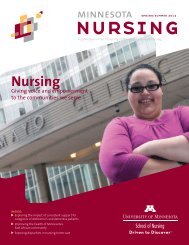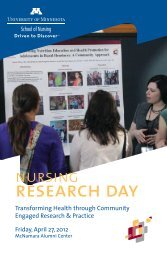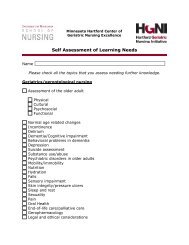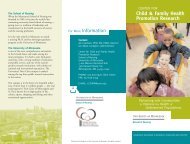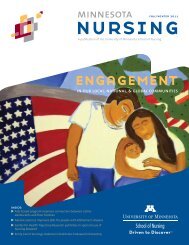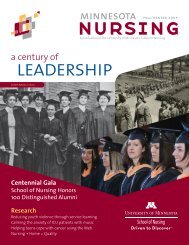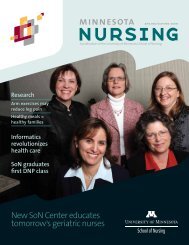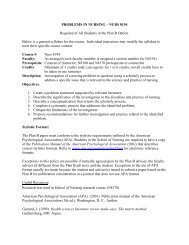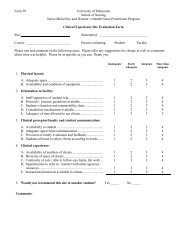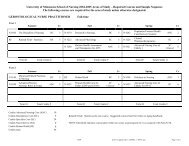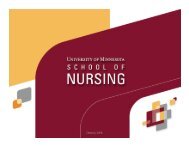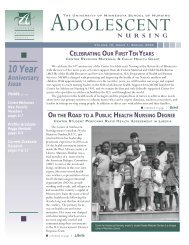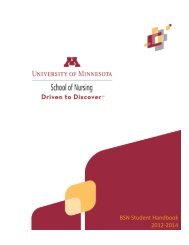Healthy Communities Innovation Center - School of Nursing ...
Healthy Communities Innovation Center - School of Nursing ...
Healthy Communities Innovation Center - School of Nursing ...
You also want an ePaper? Increase the reach of your titles
YUMPU automatically turns print PDFs into web optimized ePapers that Google loves.
university <strong>of</strong> minnesota school <strong>of</strong> nursing<br />
<strong>Healthy</strong> <strong>Communities</strong><br />
<strong>Innovation</strong> <strong>Center</strong><br />
Nurses Leading Partnerships to Improve Health and Change Lives<br />
www.nursing.umn.edu/hcic 1
interpr<strong>of</strong>essional<br />
learning community<br />
<strong>School</strong> <strong>of</strong> <strong>Nursing</strong> Associate Pr<strong>of</strong>essor Wendy Looman, PhD, RN, CNP, (right) pictured<br />
with Anna Thurmes, MA, CCC-SLP, (left) speech therapist and Cleft Palate Clinic<br />
program coordinator and Anna Colestock during a coordinated care session at the<br />
Cleft Palate Clinic located in the U <strong>of</strong> M <strong>School</strong> <strong>of</strong> Dentistry. Dr. Looman co-leads an<br />
interpr<strong>of</strong>essional team that creates coordinated care plans for families <strong>of</strong> children<br />
with special health care needs. These plans can eliminate duplication, are potentially<br />
less expensive, and improve the quality <strong>of</strong> life for children and their families.<br />
2 healthy communities learning center
The <strong>Healthy</strong> <strong>Communities</strong><br />
<strong>Innovation</strong> <strong>Center</strong><br />
A collaboration for educating our health pr<strong>of</strong>essionals to<br />
meet today’s challenges<br />
A transformation is needed in health care delivery and<br />
education to ensure that future nursing pr<strong>of</strong>essionals—<br />
our students—are prepared to meet the demands <strong>of</strong><br />
today’s evolving health care environment and to fully<br />
participate with other health care pr<strong>of</strong>essionals in<br />
addressing the challenges.<br />
The University <strong>of</strong> Minnesota <strong>School</strong> <strong>of</strong> <strong>Nursing</strong> has taken<br />
the lead in forming a collaboration among schools and<br />
colleges in the University’s health sciences and other related<br />
fields to establish an interpr<strong>of</strong>essional learning community<br />
for undergraduate, graduate, pr<strong>of</strong>essional and practicing<br />
health care pr<strong>of</strong>essionals. Called the <strong>Healthy</strong> <strong>Communities</strong><br />
<strong>Innovation</strong> <strong>Center</strong>, this collaboration will use a team<br />
approach and innovation to enhance the outcomes we<br />
can achieve through integrated, coordinated, safe, patientcentered<br />
and evidence-based care delivery.<br />
The <strong>Healthy</strong> <strong>Communities</strong> <strong>Innovation</strong> <strong>Center</strong> will be a<br />
catalyst to create:<br />
• Interdisciplinary learning scenarios that closely reflect<br />
current and future nursing care and health care<br />
innovation, simulating the full continuum <strong>of</strong> patient<br />
care to enhance quality, safety, and coordination and<br />
continuity in health care delivery.<br />
• Expanded nursing and health pr<strong>of</strong>essional training in<br />
using health information technology to improve care<br />
across delivery settings, support performance measures<br />
and reporting, and provide decision support.<br />
• An interpr<strong>of</strong>essional culture in which students develop<br />
leadership skills that prepare them to serve as partners<br />
in transforming health care.<br />
• Designing and testing <strong>of</strong> new technologies and new<br />
care ideas, centered on increased patient safety and the<br />
overall care experience.<br />
• An opportunity for established practitioners within the<br />
field to test, renew and update their skills as well as<br />
enhance their team development practices.<br />
• Team-based coordinated care integrating curricula<br />
across health science disciplines.<br />
i<br />
The <strong>Healthy</strong> <strong>Communities</strong> <strong>Innovation</strong> <strong>Center</strong> will provide all<br />
prelicensure students the opportunity to have key clinical<br />
learning experiences across health settings. These include<br />
caring for patients with key health concerns such as diabetes,<br />
identifying and responding to status changes in patients, and<br />
providing care as part <strong>of</strong> an interpr<strong>of</strong>essional team.<br />
www.nursing.umn.edu/hcic 3
A Changing Environment<br />
For health care and the role <strong>of</strong> nursing<br />
Systemic changes are underway in health care delivery in<br />
the U.S., creating change in the roles, responsibilities, and<br />
education <strong>of</strong> nurses. Nurses are being called upon to fill<br />
expanding roles, deliver care in many different settings,<br />
and master technological tools and information systems<br />
while collaborating and coordinating care across teams <strong>of</strong><br />
health pr<strong>of</strong>essionals.<br />
Some <strong>of</strong> the factors nursing must address to manage<br />
changes in health care are:<br />
An aging population: The proportion <strong>of</strong> the U.S. population<br />
aged 65 and older is on the rise, a result <strong>of</strong> increases in life<br />
expectancy and the aging <strong>of</strong> the Baby Boom generation.<br />
This has caused dramatic growth in the demand for health<br />
care services and changes in the types <strong>of</strong> care that need<br />
to be delivered.<br />
Health disparities: Inequities in the burden <strong>of</strong> disease, injury,<br />
or death experienced by socially disadvantaged groups are<br />
driven in part by socio-environmental conditions, behavioral<br />
risk factors, and systematic biases that can result in unequal,<br />
inferior treatment.<br />
Affordable Care Act: Working on the front lines <strong>of</strong> patient<br />
care, nurses can play a vital role in helping realize the<br />
objectives set forth in the 2010 Affordable Care Act.<br />
Technological innovation: Unprecedented technological<br />
innovation in health care, including the electronic health<br />
record, has become a core facet <strong>of</strong> health care delivery. With<br />
optimal use <strong>of</strong> technology, health care pr<strong>of</strong>essionals can<br />
improve health outcomes, expand care to individuals in<br />
their homes or in rural settings, and employ data to conduct<br />
research on current and new best practices.<br />
Chronic conditions: The aging population, as well as issues<br />
such as increased obesity, has shifted the health care<br />
environment to one in which there are more needs relating<br />
to chronic conditions such as diabetes, hypertension,<br />
arthritis, cardiovascular disease, and mental health<br />
conditions, in addition to acute conditions and illnesses.<br />
Home-based care: The future <strong>of</strong> nursing is about being out<br />
in communities, working with patients and their families to<br />
keep people healthy and at home.<br />
A more diverse population: Minority populations are<br />
growing and ethnic and racial demographics are changing,<br />
with respect to country <strong>of</strong> origin, primary language,<br />
immigrant status and generation, socioeconomic status,<br />
history, and culture.<br />
i<br />
Through our faculty practice and community student<br />
learning opportunities, the <strong>School</strong> <strong>of</strong> <strong>Nursing</strong> continues<br />
to grow and provide access to care across the state and<br />
country. Our nearly 250 community partners <strong>of</strong>fer valuable<br />
opportunities for research and practice related to patient<br />
access, health promotion, cost, and quality <strong>of</strong> care.<br />
4 healthy communities innovation center
the expanding role<br />
<strong>of</strong> nursing<br />
When Idil Mohamed, BSN ‘11, first began her experience at Park Elder Care <strong>Center</strong><br />
in Minneapolis, she met only a few Somali elders; at her next visit, a line had<br />
formed to talk to her. Learning about some <strong>of</strong> the challenges from the center<br />
director, Idil designed an approach, established nursing <strong>of</strong>fice hours, and earned<br />
the trust <strong>of</strong> community members—which involved more than speaking their<br />
language. In a short time, Idil gained the elders’ trust and was able to share with<br />
them practical and valuable guidance about their health and medications.<br />
www.nursing.umn.edu/hcic 5
preparing leaders<br />
Miriam Amini, BSN ‘06, conducts a health consultation with a mother<br />
and daughter during their visit to the Indian Health Board—an organization<br />
that provides for the health needs <strong>of</strong> the American Indian community living in<br />
Minneapolis’ Phillips neighborhood.<br />
6 healthy communities innovation center
Preparing Nurse Leaders<br />
In a changing environment<br />
The changing environment <strong>of</strong> health care places new<br />
pressures and requirements on the 3 million nurses in<br />
the U.S. who deliver patient care in settings ranging from<br />
hospitals, schools, homes, retail health clinics, long-term<br />
care facilities, battlefields, and community and public health<br />
centers. With their focus on direct patient care, as well as<br />
care coordination, nurses bring valuable insights, leadership<br />
skills, and unique abilities to contribute as partners with<br />
other health care pr<strong>of</strong>essionals in addressing the challenges<br />
<strong>of</strong> health care today to improve the quality and safety<br />
<strong>of</strong> care.<br />
According to a new landmark report from the Institute <strong>of</strong><br />
Medicine and The Robert Wood Johnson Foundation entitled<br />
The Future <strong>of</strong> <strong>Nursing</strong>: Leading Change, Advancing Health<br />
(2010), the roles, responsibilities, and education <strong>of</strong><br />
nurses – the largest segment <strong>of</strong> our nation’s health care<br />
workforce – require transformational change to meet the<br />
increased demand for care that will be created by health<br />
care reform and to advance improvements in America’s<br />
increasingly complex health system. These changes are<br />
needed in the pr<strong>of</strong>ession and in nursing education to meet<br />
the increased demand for care, leadership, and the growing<br />
complexity <strong>of</strong> health care delivery.<br />
“Transforming the nursing pr<strong>of</strong>ession is a crucial element<br />
to achieving the nation’s vision <strong>of</strong> an effective, affordable<br />
health care system that is accessible and responsive to all,”<br />
said Linda Burnes Bolton, vice chair <strong>of</strong> the committee that<br />
produced this Institute <strong>of</strong> Medicine Report.<br />
The <strong>Healthy</strong> <strong>Communities</strong> <strong>Innovation</strong> <strong>Center</strong> will provide<br />
expanded opportunities for nursing and interpr<strong>of</strong>essional<br />
collaboration to enhance quality, safety, care coordination,<br />
and continuity which are key to transforming nursing and<br />
health pr<strong>of</strong>essional education and the health care system.<br />
i<br />
<strong>School</strong> <strong>of</strong> <strong>Nursing</strong> academic programs prepare outstanding<br />
nurse leaders who are committed to developing holistic<br />
models <strong>of</strong> care. Our programs include the Bachelor <strong>of</strong> Science<br />
in <strong>Nursing</strong> (BSN), Master <strong>of</strong> <strong>Nursing</strong> (MN), Doctor <strong>of</strong> <strong>Nursing</strong><br />
Practice (DNP), and PhD programs.<br />
www.nursing.umn.edu/hcic 7
Facility Renovation<br />
A critical step in the transformation <strong>of</strong> education<br />
A key step in meeting the goals <strong>of</strong> the <strong>Healthy</strong> <strong>Communities</strong><br />
<strong>Innovation</strong> <strong>Center</strong> is to renovate the Weaver-Densford Hall<br />
fourth floor nursing skills laboratory and related <strong>of</strong>ficeclassroom<br />
space into a high-tech simulation-oriented<br />
learning environment.<br />
The current skills laboratory used by BSN, Master’s <strong>of</strong> <strong>Nursing</strong><br />
and DNP students is 25 years old. Most <strong>of</strong> the equipment<br />
is outdated and in poor repair, and not in keeping with<br />
current real-world environments in which graduates will<br />
work. Students in the nursing specialty programs use other<br />
high-tech teaching facilities within the Academic Health<br />
<strong>Center</strong>, however, there is insufficient exposure to a holistic,<br />
team-based, multi-setting care approach which will be a core<br />
focus <strong>of</strong> the HCIC. Additional technologically sophisticated<br />
team-based learning spaces are also needed to support the<br />
learning that takes place in the innovation lab.<br />
The new innovation lab and related classroom<br />
renovation will:<br />
• Create a contemporary simulation-oriented learning<br />
environment in which students will learn skills from the<br />
basic to specialist level, acute to primary care, in diverse<br />
delivery settings and with multiple disciplines.<br />
• Create technologically sophisticated classrooms that will<br />
serve state-wide and beyond pr<strong>of</strong>essional education in<br />
nursing and the health sciences.<br />
• Expand pr<strong>of</strong>essional training in the integration <strong>of</strong><br />
electronic health records and supportive technologies<br />
across health care environments.<br />
The HCIC will include simulated environments that<br />
span the continuum <strong>of</strong> care. These include acute,<br />
skilled, ambulatory, and home care settings. The<br />
acute care space can be modified to be critical care,<br />
medical-surgical care, or an emergency room. There<br />
will be an observation space and control room,<br />
demonstration and debriefing space, and small and<br />
large classrooms. The center will be equipped with<br />
an electronic health record, portable computers and<br />
tablets, and wireless devices that support telehealth.<br />
There will be video-taping and replay capability.<br />
8 healthy communities innovation center
educating the best<br />
Why Now? Why Minnesota?<br />
Never before have we witnessed such dramatic shifts in<br />
health care delivery. Significant systemic changes are already<br />
underway and will significantly impact the ways and places<br />
in which health care is delivered in the near future. Every<br />
citizen, regardless <strong>of</strong> economic status, gender, ethnicity, or<br />
age will be impacted by the rapidly emerging changes in<br />
health care delivery. Creating new education models and<br />
achieving a more educated nursing workforce are keys to<br />
meeting the emerging health care needs <strong>of</strong> our state and<br />
nation.<br />
The <strong>School</strong> <strong>of</strong> <strong>Nursing</strong> and its partners in the Academic<br />
Health <strong>Center</strong> at the University <strong>of</strong> Minnesota have long<br />
been recognized as world leaders in health care education.<br />
The development <strong>of</strong> the <strong>Healthy</strong> <strong>Communities</strong> <strong>Innovation</strong><br />
<strong>Center</strong>, with a new state-<strong>of</strong>-the-art simulation laboratory<br />
and high-tech classrooms, will ensure the University’s ability<br />
to continue to attract, retain, and educate the best and<br />
brightest health care leaders.<br />
• The <strong>School</strong> <strong>of</strong> <strong>Nursing</strong> is one <strong>of</strong> only 41 doctoral research<br />
universities in the U.S. It is ranked in the top five percent<br />
<strong>of</strong> public and private nursing schools, and is the only<br />
school in Minnesota that prepares PhD nurses.<br />
• The Doctor <strong>of</strong> <strong>Nursing</strong> Practice (DNP) program is one <strong>of</strong><br />
the largest in the nation and features 14 specialty areas<br />
including Integrative Health and Healing, Midwifery,<br />
Nurse Anesthesia and Informatics – the first <strong>of</strong> their kind<br />
in the country!<br />
• Our extensive community partnerships and<br />
collaborations across disciplines at the University <strong>of</strong><br />
Minnesota help prepare our graduates to work as<br />
members <strong>of</strong> inter-pr<strong>of</strong>essional teams, to be leaders in<br />
health care systems, to provide patient care as advanced<br />
practice nurses, and to conduct research to improve care<br />
through evidence-based practice.<br />
www.nursing.umn.edu/hcic 9
A Philanthropic Opportunity<br />
What you can do to help make this happen<br />
Through the creation <strong>of</strong> the <strong>Healthy</strong> <strong>Communities</strong><br />
<strong>Innovation</strong> <strong>Center</strong> the <strong>School</strong> <strong>of</strong> <strong>Nursing</strong> will help shape<br />
and implement the transformation <strong>of</strong> health pr<strong>of</strong>essional<br />
education and care delivery necessary to meet the<br />
challenges <strong>of</strong> the evolving health care environment. Leading<br />
the way in these areas continues the <strong>School</strong> <strong>of</strong> <strong>Nursing</strong><br />
and Academic Health <strong>Center</strong>’s tradition <strong>of</strong> excellence and<br />
innovation in education, research, and practice.<br />
Financial contributions are needed to make the renovation<br />
<strong>of</strong> our facilities possible, and to support the operation <strong>of</strong><br />
the <strong>Healthy</strong> <strong>Communities</strong> <strong>Innovation</strong> <strong>Center</strong>. Donors have<br />
the opportunity to be part <strong>of</strong> a transformation in health<br />
care education that will have a pr<strong>of</strong>ound influence on the<br />
countless citizens who will benefit from improved care,<br />
effective leadership, and innovative practices.<br />
a pr<strong>of</strong>ound<br />
influence<br />
10 healthy communities innovation center
Our Mission<br />
The mission <strong>of</strong> the <strong>School</strong> <strong>of</strong> <strong>Nursing</strong> is to generate knowledge<br />
and prepare nurse leaders who will create, lead, and participate<br />
in holistic efforts to improve the health <strong>of</strong> all people within the<br />
context <strong>of</strong> their environments.<br />
For More Information<br />
For more information about how you can support the<br />
<strong>Healthy</strong> <strong>Communities</strong> <strong>Innovation</strong> <strong>Center</strong> contact:<br />
Gigi Fourré Schumacher<br />
Director <strong>of</strong> Development<br />
University <strong>of</strong> Minnesota <strong>School</strong> <strong>of</strong> <strong>Nursing</strong><br />
612 625-1365<br />
gschumac@umn.edu<br />
5-140 Weaver-Densford Hall<br />
308 Harvard Street S.E.<br />
Minneapolis, MN 55455<br />
www.nursing.umn.edu
healthy communities<br />
innovation center<br />
©2011 Regents <strong>of</strong> the University <strong>of</strong> Minnesota. All rights reserved.<br />
The University <strong>of</strong> Minnesota is an equal opportunity educator and employer.<br />
This publication can be made available in an alternate format upon request.<br />
Direct requests to the Publications Manager at nursnews@umn.edu or 612-626-1817.<br />
Printed on recycled paper with 10 percent total recovered fiber/all post-consumer fiber.<br />
750/08-2011



